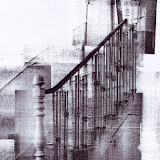
This project has a strange trajectory. It began with a series of speculative abstract drawings made using a technique of frottage and cutting and folding paper. Some of the qualities of these reminded me of why light falls from above across the complex curves of Borromini's churches. At the time I was frequenting a local cafe called Cafe Bohemia under some railway arches (my usual haunt being closed for refurbishment). The cafe had a scruffy charm but rather spoiled it with some kitsch-but-not-in-a-good-way touches. I would enter and walk through passing underneath the railway arch to a section at the back which had a large roof light. I love this space. It has some fantastic latent qualities hiding just under the surface. I decided to use some of the spatial protocols I had seen in the rubbings to articulate my reading of the specialness of this space.
The space at the back of the cafe has a latent vertical and horizontal structure set up by the railway. The space is clearly divided into two horizontally by the railway which operates on a level plane above the world of the city below. In this upper zone was the railway - perhaps the example of an autonomous, rational, causal system (and one that conspicuously breaks down...). In the lower zone was the cafe where I was eating my lunch - perhaps the example of a typical everyday human situation. The space at the back established a vertical axis between the two by way of allowing light to enter from above - although it did this with no drama or excitement. The noise of the trains was also discernible albeit only dimly. This reminded me both of a cosmological structure (horizontal and vertical) but also of the vertical structure of the Bachelor Machines, particularly the punishment mechanism of Kafka's In A Penal Colony which comprised the supposedly rational mechanism of justice above and the body below.
The intervention proposes highlighting the vertical connection between the two worlds of the railway and the cafe. In the final scheme the roof of the back area of the cafe is raised creating a large south facing window. 3 beams (working like levers) span from pin joints with the structure at the window end to a spring and finally are attached to the sleepers of the train tracks above. As the trains run past the gentle movement of the sleepers rocks the beam. This in turn shakes a series of 12 hanging vertical metal pieces which glint in the light from the south facing window. Thus the project firstly creates a vertical space with light from above falling onto the dining space suggesting a cosmological reading. Secondly the the project emphasises the upper world of the railway by making the passing trains interfere with the lighting via the mechanism. Moreover this upper zone is now representative not just of the railway but of the mechanical more generally and, by analogy, the world of the causal, technical and rational which dominates our culture.
drawings: http://picasaweb.google.com/bensweeting/CafeBohemia2010#
see also: 'Architecture and Undecidability - Cafe Bohemia' in PhD Research Projects 2010. the Bartlett School of Architecture, UCL, UK, pp. 163-167, 2010.
see also: 'Architecture and Undecidability - Cafe Bohemia' in PhD Research Projects 2010. the Bartlett School of Architecture, UCL, UK, pp. 163-167, 2010.





